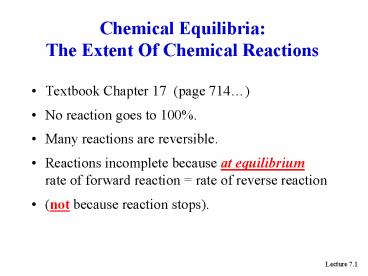Chemical Equilibria: The Extent Of Chemical Reactions - PowerPoint PPT Presentation
1 / 12
Title:
Chemical Equilibria: The Extent Of Chemical Reactions
Description:
time. concentration. N2O4. NO2. equilibrium. attained. Equilibrium concentrations the same, ... A particular Kc has meaning only in relation to particular equation. ... – PowerPoint PPT presentation
Number of Views:109
Avg rating:3.0/5.0
Title: Chemical Equilibria: The Extent Of Chemical Reactions
1
Chemical EquilibriaThe Extent Of Chemical
Reactions
- Textbook Chapter 17 (page 714)
- No reaction goes to 100.
- Many reactions are reversible.
- Reactions incomplete because at equilibriumrate
of forward reaction rate of reverse reaction - (not because reaction stops).
2
Dynamic Equilibrium
- forward (L to R) and reverse (R to L) reactions
occur simultaneously.
brown
colourless
Equilibrium concentrations the same, whatever
the starting composition.
3
Equilibrium Constant
- At equilibrium, concentrations given by Law of
Mass Action
- equilibrium constant
- (often omit subscript eq)
- Law of Mass Action first deduced from
experiment, then proved from laws of
thermodynamics
4
Relation between Keq and Rate Coefficients
- Take system with elementary reactions, eg
For Elementary reactions (unimolecular and
bimolecular)
At equilibrium forward rate reverse rate, so
5
Example
2NO(g) O2 (g) ? 2NO2 (g) net reaction
Rate rate of slow step k N2O2O2
So rate k N2O2 O2 k K NO2 O2 hence
rate constant ? NO2 O2 consistent with
observed rate law
6
Kc Equilibrium Constant with respect to
Concentration
- units M (mol L-1)
- Units of Kc depend on values of a, b, c d
7
Kp Equilibrium Constant with respect to Partial
Pressure
- Reaction involving gases
- pA partial pressure of A at equilibrium...
8
Example
- Cl2 is placed in a vessel and heated to 1400 K.
- When equilibrium reached we find
- pCl2 1 atm, pCl 2.97 x 102 atm.
- What is the value of Kp at 1400 K?
(units!)
9
Relationship Between Kp Kc
- pV nRT
- so Kc Kp(RT)-1 for this particular reaction
- In general
Dn (ngas products ngas reactants)
10
Example
- Having found Kp at 1400 K, find Kc at 1400 K
consistent units!
11
Magnitude Of Equilibrium Constants
- A particular Kc has meaning only in relation to
particular equation. - If the reaction has same number of moles on each
side (ie Kc is dimensionless) - if Kc gt 1 mostly products at equilibrium
- if Kc lt 1 mostly reactants at equilibrium
- if Kc 1 equal number of moles reactant
product
12
Using Equilibrium Constants
- Determined by experiment can be predicted from
theory for certain systems - Independent of initial concentrations
- Independent of the presence of inhibitors or
catalysts - Dependent on temperature (T must be given for
each Kc value)































